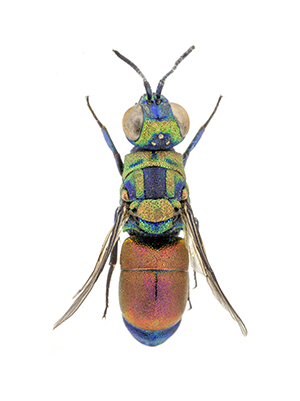Last updated on November 28th, 2023
 From: Kimsey L.S. & Bohart R.M., 1990 (1991) – The chrysidid wasps of the world. Oxford University Press, ix-652 pp.
From: Kimsey L.S. & Bohart R.M., 1990 (1991) – The chrysidid wasps of the world. Oxford University Press, ix-652 pp.
Synonymy
Pseudochrysis Semenov 1891:444. Type: Pseudochrysis virgo Semenov 1891b:44l. (Chrysis singularis Spinola. 1838:452). Desig. by Richards 1935:158.
Pseudospinolia Linsenmaier 1951:65. Type: Chrysis uniformis Dahlbom 1854:149. Orig. desig.
Neospinolia Linsenmaier 1968:39. Type: Chrysis tertrini Buysson 1898:549. Orig. desig. and monobasic.
Generic diagnosis
Face with discrete medial impunctate stripe or zone of cross ridging, dense appressed silver pubescence laterally at least in males; TFC present; malar space 0.5-1.0 MOD long; mandibles tapering apically with shallow subapical notch but no teeth; tongue long; F-I length 2.0-3-5 times breadth; pronotal anterior declivity with four pits, lateral fovea deep, sharp edged, and subdivided by strong ridge; mesopleuron with episternal sulcus indicated at least as a shallow depression, scrobal sulcus irregular and often faintly indicated, subtended by irregularly V-shaped enclosure formed by verticaulus and omaulus; fore wing Rs long but bending slightly away from costal margin, leaving marginal cell broadly open; T-III with large prepit swelling, pits considerably larger than adjacent punctures, apical rim smooth without crenulations or teeth, female T-V with some apicolateral ridges; S-V unmodified; T-VI with apicomedial tooth.
Hosts
Members of this genus apparently parasitize Eumenidae. Odynerus spinipes (Linnaeus) and O. reniformis (Gmelin) have been reported as hosts of neglecta, and Paravespa grandis (Morawitz) the host of humboldti (Linsenmaier 1959a).
Distribution
The majority of Pseudochrysis occur in the Palearctic Region, particularly in the southern USSR and in Algeria. One species, tumida, appears to be restricted to Ethiopia. Pseudochrysis neglecta has a Holarctic distribution, occurring in both Europe, northern China, Mongolia, and northern North America. In addition, there is one species in southern Africa, ardoris, and one in Chile, tertrini.
Discussion
The question of whether Pseudospinolia (now Pseudochrysis) is a distinct group has had a variety of answers since it was first treated as a subgenus of Euchroeus by Linsenmaier (1959a). Kimsey (1983) synonymized Pseudospinolia under Spinolia based on a relatively small number of species. We have re-evaluated these groups and have concluded that Pseudospinolia is indeed a valid genus, the primitive sister group of Spinolia + Euchroeus. These three genera all have a broadly open marginal cell, a well-developed scrobal sulcus, slender and unidentate or edentate mandibles, and a long clypeus. Diagnostic features for Pseudospinolia are: T-III apically edentate and smooth, mesopleuron with broad, irregularly V-shaped enclosure below the scrobal sulcus, pronotal side with depression deep and subdivided by a carina, and face with a TFC.). Species distinctions are based to a large extent on colour and facial dimensions. Palearctic species are generally bicoloured with the head and thorax blue, purple, or green and the abdomen brassy green co coppery red. There are some variations in this basic pattern. In uniformis the pronotum, scutellum, and metanotum are concolorous with the terga. T-III in humboldti and incrassata is dark blue or purple. Finally, aureicollis has only the pronotum concolorous with the terga. In contrast the southern African species ardoris, is entirely coppery, and tertrini from Chile is blue green. The shape of T-III tends to be sexually dimorphic in Pseudospinolia. In males T-III is subtruncate with the apicomedial margin broadly curved. Females have T-III drawn out apicomedially so that the margin is sharply curved.
European species
- Pseudochrysis aureicollis (Abeille, 1878)
- Pseudochrysis fahringeri (Trautmann, 1926)
- Pseudochrysis gratiosa maculicornis (Perraudin, 1978)
- Pseudochrysis humboldti (Dahlbom, 1845)
- Pseudochrysis humboldti sculpturatissimus (Linsenmaier, 1959)
- Pseudochrysis incrassata (Spinola, 1838)
- Pseudochrysis incrassata minor (Mocsáry, 1889)
- Pseudochrysis incrassata minuta (Mocsáry, 1889)
- Pseudochrysis incrassata paris (Linsenmaier, 1997)
- Pseudochrysis marqueti (Buysson, 1887)
- Pseudochrysis neglecta (Shuckard, 1837)
- Pseudochrysis trasversa (Dahlbom, 1854)
- Pseudochrysis uniformis (Dahlbom, 1854)
Copyright, Authorship, and Ownership statements
All text and images of this page are copyright ©️ Chrysis.net unless otherwise stated - please see individual cases for authorship and copyright details. The specimens pictured are from the authors' or other collaborators' personal collections and from the collections of various museums. Unless otherwise specified, the whole content of this web site is for personal, non-commercial, scientific, and educational purposes given proper accreditation to the page from which they were derived are provided, and under Chrysis.net Terms and Conditions.
For citation purposes
Agnoli G.L. & Rosa P. (2024) Genus Pseudochrysis Semenov, 1891, in: Chrysis.net website. Interim version 26 April 2024, URL: https://www.chrysis.net/database/genus-pseudochrysis/.




